There are approximately 4 cups of dog food in a pound. This can vary based on kibble size and density.
Choosing the right amount of dog food is crucial for your pet’s health and well-being. The process starts with understanding the basic conversion ratios, which help dog owners gauge how much to feed their furry friend each day. A common question among pet owners is about the quantity of food, measured in familiar kitchen measurements, that their pet requires.
Knowing there are around 4 cups of dry dog food in one pound allows for proper meal planning and ensures that pets receive the right amount of nutrition. It’s also essential for managing food supply and anticipating when to purchase more without overstocking or running out. This standard measurement can guide portion control, which is instrumental in preventing obesity or malnourishment in dogs. Keeping these considerations in mind helps maintain a healthy, happy canine companion.

Credit: damndelicious.net
Understanding Dog Food Measurements
When it comes to feeding your furry friend, knowing precisely how many cups of dog food in a pound can make all the difference. This simple conversion is pivotal for providing a balanced diet and maintaining your dog’s ideal weight. Accurately measuring dog food ensures that your pet gets the correct amount of nutrients without overfeeding or underfeeding.
Importance Of Accurate Measurements For Maintaining Dog’s Health
Ensuring your dog receives the right quantity of food is crucial for their overall health. An excess or deficiency in their diet could lead to various health complications, including obesity, malnutrition, or even more severe health issues. It’s not just about the number of cups; it’s about making sure each serving is as precise as possible for your dog’s specific dietary needs.
- Prevents overfeeding and obesity
- Avoids the risks of underfeeding and nutrient deficiencies
- Helps manage specific health conditions with a controlled diet
- Supports healthy growth and development in puppies
Brief Comparison Of Weight Vs. Volume Measurements
When scooping out your dog’s food, understanding the difference between weight and volume measurements is key. Weight (pounds, kilograms) is a more accurate and consistent method to measure dog food because it isn’t affected by the shape or size of the kibble. In contrast, volume (cups, milliliters) can vary greatly. For example, one cup of a dense, small-sized kibble could weigh more than a cup of larger-sized, airy kibble. Here’s why weight measurements are often preferred:
- Weight is more precise: It accounts for the density and size differences in dog food.
- Variation in cup sizes can lead to inconsistent feeding.
- Many vets and pet food manufacturers recommend weighing dog food for accurate portioning.
Common Misconceptions Clarified
Several misconceptions about dog food measurements can lead to improper feeding. It’s time to clarify these for the well-being of your pet:
- “A cup is always a cup”:
- – The volume of a cup can vary depending on the type of food and the scoop used.
- “All dog food has the same density”:
- – Different brands and types of dog food have varying densities, affecting how much fits in a cup.
- “A pound of dog food is always the same number of cups”:
- – The conversion from pounds to cups changes based on kibble size and density.
Converting Pounds To Cups In Dog Food
When it comes to feeding your furry friend, one question often arises: How many cups of dog food are in a pound? It sounds like a simple conversion, but several factors make it a bit more complicated than it appears. The relationship between weight and volume in dog food can vary, making a standard conversion difficult to nail down. Yet, understanding how to convert pounds to cups accurately is crucial for maintaining your dog’s health and ensuring they receive the proper amount of nutrition. Let’s take the guesswork out of this conversion and explore what you need to know for mealtime.
Factors Influencing Volume-to-weight Conversion
The conversion from pounds to cups can be influenced by various factors that affect the density and volume of dog food. Moisture content, air space between kibbles, and the physical characteristics of the food all play a role in determining how much volume a given weight of dog food will occupy. Understanding these complexities is critical to ensure you’re providing your dog with the right amount of food.
Dog Food Brand Disparities
Not all dog food brands are created equal. Differences in ingredients and formulation can lead to significant disparities in how much a cup of one brand weighs compared to another. Some brands may use heavier grains or fillers, which could result in more weight per cup, while others might offer a lighter, airier product that takes up more volume for the same mass. This variability is crucial to consider when measuring out your dog’s meals.
Kibble Size And Density Variations
Kibble comes in all shapes and sizes, and these factors can greatly affect the number of cups in a pound of food. Smaller kibbles often have less air space between each piece, potentially leading to a heavier cup, while larger kibbles can create more air space and a lighter cup. Density is another key aspect; some foods are packed tightly and will weigh more, whereas others are more loosely constructed. These characteristics must be considered for an accurate conversion.
Quick Reference Tips For Conversion
To streamline meal preparation, consider these quick reference tips for converting pounds to cups in dog food:
- A standard guideline is that one pound of dog food approximately equals four cups, but this can vary widely based on the factors above.
- Use the feeding guide on the dog food package as a starting point. It usually provides a reasonable estimate tailored to the specific brand and formula.
- Invest in a kitchen scale and measure the food once, noting how many cups correspond to the weight your dog requires. This will give you a more precise measurement going forward.
- Create a conversion table specific to your dog’s food for easy reference, and adjust if you switch brands or formulas.
Remember, while consistency in feeding is important, monitoring your dog’s weight and health is the best way to ensure they’re getting the correct amount of food. Adjustments might be necessary over time, especially if your dog’s level of activity changes or if they have special dietary needs.
How Many Cups In One Pound Of Dog Food
Measuring the right amount of dog food is crucial for maintaining your furry friend’s health. But have you ever wondered, how many cups in one pound of dog food? Whether you’re switching brands, changing diet types, or just trying to confirm feeding guidelines, understanding this simple conversion can help you ensure your dog is getting the right quantity of food.
General Guideline And Rule Of Thumb
The number of cups in one pound of dog food can vary significantly depending on the brand and type of food. Different ingredients can make the food denser or lighter. The general rule of thumb is that one pound of dry dog food is equivalent to approximately four cups. However, this is a rough estimate, and it’s essential to look at specific brands for more accurate measurements.
Examples With Different Dog Food Brands
Different brands of dog food have different densities. Here’s a comparison of how many cups are in one pound of food for various dog food brands:
| Brand | Density (Cups per Pound) |
|---|---|
| Brand A | 4 cups |
| Brand B | 3.8 cups |
| Brand C | 3.5 cups |
| Brand D | 4.2 cups |
Keep in mind that these are approximate values. It’s best to check the label on the dog food bag for the most accurate feeding guide or consult with a vet for personalized advice.
Tailoring Portions To Your Dog’s Needs
Understanding how many cups of dog food equate to a pound is essential for maintaining your dog’s health. Yet, what’s even more crucial is tailoring your dog’s diet according to their unique requirements. Different breeds, sizes, and activity levels call for varying food amounts. Let’s dive into tailoring dog food portions to ensure your furry friend stays happy and healthy.
Considering Dog’s Size, Breed, And Activity Level
Every dog is unique, and factors such as size, breed, and activity level play a significant role in determining the right food portions. Smaller breeds typically require less food compared to larger dogs due to their lower caloric needs. Additionally, a dog’s activity level can significantly impact the amount of food they require. Active dogs burn more calories and may need larger servings to maintain their energy levels.
- Small breeds: Generally need between 1/2 cup to 1 1/3 cups per day
- Medium breeds: Usually require around 1 3/4 cups to 2 2/3 cups per day
- Large breeds: Often need between 2 1/2 cups to 3 cups or more daily
Adjust these portions based on your specific dog’s breed and their day-to-day activities.
Importance Of Consistent Measuring Practices
Adopting consistent measuring practices for dog food is paramount to avoid overfeeding or underfeeding. Inaccurate measuring can lead to weight gain or malnutrition. To ensure consistency:
- Use a standard measuring cup to measure the dog food.
- Level off the cup to make sure you’re not overfilling it.
- Keep a feeding schedule to monitor daily intake.
Stay true to these practices and keep an eye on the dog’s body condition to maintain optimal health.
Adjusting Servings For Weight Management
Managing your dog’s weight is often a fine balance. If weight gain is an issue, try reducing the daily portions marginally and incorporate more exercise. On the other hand, underweight dogs may require an increased intake or more calorie-dense food. Always implement these changes gradually to give your dog’s system time to adjust.
| Condition | Portion Adjustment | Additional Notes |
|---|---|---|
| Weight Loss | Decrease by 10% | Increase exercise |
| Weight Gain | Increase by 10% | Monitor body condition closely |
| Maintenance | No change needed | Consistent measuring is key |
Note the body changes and consult with a veterinarian before making significant alterations to your dog’s diet.
Accurate Measurement Tools For Dog Owners
Knowing exactly how many cups of dog food fit in a pound is critical for maintaining your furry friend’s health. Precision in feeding not only contributes to their overall well-being but can also prevent obesity and related health issues. The cornerstone of this precision lies in using the right measurement tools. Below, explore the most reliable instruments to quantify your dog’s daily intake and keep them on a balanced diet.
Recommended Types Of Measuring Cups And Scales
Choosing suitable measuring cups and scales is vital for accurate food portioning. Remember, all measuring cups are not created equal.
- Standard Measuring Cups: Perfect for dry food, they should have clear markings to show different levels of volume.
- Digital Scales: These provide the most precise measurements, especially recommended if your dog is on a strict diet.
A table can illustrate how different tools compare in accuracy:
| Tool Type | Accuracy | Best Use Case |
|---|---|---|
| Standard Measuring Cups | Good | Dry food measurement |
| Digital Scales | Excellent | Precise diet control |
Tips For Maintaining Consistency In Feeding
Maintaining a consistent feeding routine ensures your dog stays healthy. Here are some quick tips:
- Use the same measuring tool consistently.
- Level the cup or scale after each measure to avoid overfeeding.
- Keep a feeding schedule to regulate your dog’s meal times.
- Monitor your dog’s appetite and adjust portions accordingly.
Importance Of Regular Portion Checks
Regular portion checks are essential to adapt your dog’s diet to their changing needs:
- Prevent weight gain: By ensuring you’re not feeding too much.
- Address dietary changes: Adjusting portions as your dog ages or their activity level changes.
Ultimately, the accuracy of meal portions can significantly affect your dog’s health and longevity, emphasizing the importance of using the right measurement tools and conducting regular portion reviews.
Frequently Asked Questions Of How Many Cups Of Dog Food In A Pound
How Many Cups Are In One Pound Of Dog Food?
The amount of cups in one pound of dog food can vary. Typically, the range is between 2 to 4 cups per pound. It largely depends on the density and size of the kibble. Always check the feeding guide on your dog food packaging for precise measurements.
Can Dry And Wet Dog Food Measurements Differ?
Yes, dry and wet dog food measurements differ significantly. One pound of dry dog food roughly translates to 2 to 4 cups, whereas wet food is measured by weight, not volume. For wet food, refer to the can’s label for the weight.
What Is The Best Method To Measure Dog Food?
The best method to measure dog food is to use a measuring cup. Always level off the cup to ensure you’re providing consistent portions. It’s vital for maintaining your dog’s health and avoiding overfeeding.
Does Kibble Size Affect Food Volume In Cups?
Kibble size indeed affects food volume in cups. Smaller kibble can pack more tightly into a measuring cup, whereas larger kibble takes up more space. This can result in fewer cups per pound for bigger-sized kibble.
Conclusion
Determining the number of cups per pound of dog food keeps your pet’s diet consistent. This simple guide helps measure portions accurately, promoting your furry friend’s health and happiness. Remember, individual needs vary, so adjust as required. For tailored advice, consult your vet.
Keep serving meals with love—and precision!






